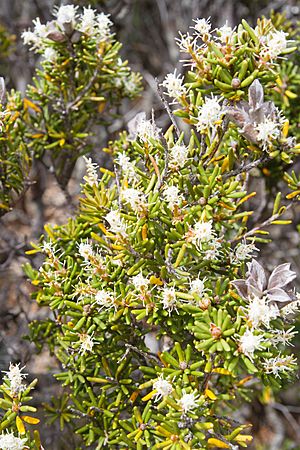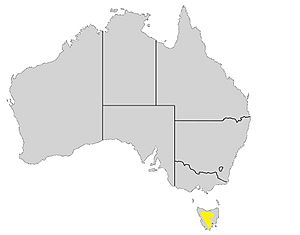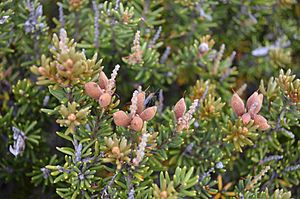Narrow-leaf orites facts for kids
Quick facts for kids Narrow-leaf orites |
|
|---|---|
 |
|
| Orites revolutus, Walls of Jerusalem National Park |
|
| Scientific classification | |
| Genus: |
Orites
|
| Species: |
revolutus
|
| Synonyms | |
|
Orites revoluta |
|
Orites revolutus, also known as narrow-leaf orites, is a special plant found only in Tasmania. It belongs to the Proteaceae plant family. A Scottish botanist named Robert Brown first described this plant in 1810. He found a sample near Lake St Clair.
This plant is common in high mountain areas and subalpine heaths. It is a small to medium-sized bush, usually about 0.5 to 1.5 meters (1.5 to 5 feet) tall. It has small, blunt leaves that are tightly rolled at the edges. Its white flowers grow on spikes at the ends of branches during summer. Since it's a proteaceaous plant, O. revolutus probably provides a lot of food for animals that eat nectar, like birds and insects, in its habitat.
Contents
What it Looks Like
Orites revolutus can grow as a wide, spreading bush or a tall, woody shrub. It is usually between 0.5 and 1.5 meters (1.5 to 5 feet) tall. It has many branches, and its leaves grow one after another along the stem.
The leaves are narrow and a bit blunt at the tip. They are about 7–20 millimeters (0.3–0.8 inches) long and 1-1.5 millimeters (0.04–0.06 inches) wide. Their edges are tightly rolled inwards, and the underside of the leaves is hairy.
The plant flowers in early to mid-summer. Its flowers have a slightly sour smell and grow on spikes that are about twice as long as the leaves. The white flowers are 5 millimeters (0.2 inches) long. They are symmetrical, like a star, and have both male and female parts. They have four pollen-producing parts (stamens) and an upper seed-producing part (ovary). The flower petals are joined together in a tube when they are buds, but they split open when mature.
After flowering, the plant produces a hairy fruit called a follicle. This fruit can be up to 15 millimeters (0.6 inches) long and contains seeds with wings.
Sometimes, people confuse Orites revolutus with another plant called Olearia ledifolia. However, Olearia ledifolia does not have the woody fruits that Orites revolutus does.
Plant History and Naming
Orites revolutus is one of nine species in the plant group called Orites. Seven of these species are found only in Australia, and four are only in Tasmania. The other two Orites species live far away in the Chilean Andes and Bolivia.
Scientists believe that the Orites group spread across the ancient supercontinent called Gondwana. This journey went from South America to Australia a very long time ago, reaching Australia by the Early Oligocene epoch. Fossils of Orites revolutus that look just like today's plants have been found in western Tasmania. This shows the species has been around for at least since the Early Pleistocene epoch.
The name Orites revoluta was first published in 1810 by Robert Brown. The name "revoluta" refers to the tightly rolled edges of the leaves. However, the name Orites revolutus is also widely used and is often considered the more correct species name.
Brown also created the name for the whole Orites group. He named it after the Greek word oreites, which means "a mountaineer." This name fits because these plants often grow in mountainous areas.
Where it Grows
Orites revolutus is found only in Tasmania. It grows widely on mountain plateaus at heights between 700 and 1300 meters (2,300 to 4,300 feet) above sea level. You can find it in rocky areas with well-drained soil, within alpine and subalpine heaths and woodlands. It can grow on different types of rock, including dolerite and sedimentary rocks.
The average temperature where this plant lives is around 8°C (46°F). It also gets a lot of rain, usually between 1700 and 2000 millimeters (67 to 78 inches) each year.
You can see Orites revolutus in many places across Tasmania. These include the Hartz Mountains, Mount Field, Cradle Mountain-Lake St Clair, and Ben Lomond National Parks. It also grows in Wellington Park, which is close to Tasmania's capital city, Hobart.
Ecology and Life Cycle
Orites revolutus is a common shrub in the tough, dry heath and woodland areas of Tasmania's mountains. It often grows alongside other plants like Epacris serpyllifolia, Baeckea gunniana, Richea sprengelioides, Eucalyptus coccifera, Empodisma minus, Leptospermum rupestre, and Orites acicularis. The two Orites species, O. revolutus and O. acicularis, often grow in similar places and are equally common.
Flowers and Pollination
The white, sour-smelling flowers appear on spikes in early to mid-summer, usually in December and January. Studies of Orites plants in other places suggest that small to medium-sized insects pollinate them. These insects include bees from groups like Lasioglossum and Hylaeus, and many types of flies. All these insects are found in Tasmania. This fits with how many Orites species have purple lines on their white or cream petals, which are like guides for bees.
Seeds and Parasites
Many seeds grow inside hairy fruits (follicles) over the next few months. Orites revolutus can be heavily attacked by a seed parasite called Symphygas nephaula. This moth lays its eggs in the flower bud before the fruit forms. Once the eggs hatch, the young larvae eat the seeds as they grow. This moth prefers Orites revolutus over O. acicularis, even though they grow in the same areas. Plants at lower elevations are more likely to be infested. Scientists think this parasite might be the main reason why many seeds are lost before they can spread.
Seed Spreading and Growth
When the fruits are mature, they dry out and split open, releasing the seeds into the nearby soil. These seeds will stay in the soil until something big happens, like a wildfire, to make them sprout. Or, they might just become too old to grow.
Studies show that mountain heath areas usually don't have fires for more than 250 years. It's unlikely that many seeds can survive in the soil for that long. This means that O. revolutus plants mostly grow new plants from underground stems, not from seeds. Most young plants are actually new shoots from existing plants. So, even though many seeds are eaten by parasites, it might not affect how many new plants grow much. O. revolutus is also one of the few plants in its community that can regrow after a fire, which is a special ability that O. acicularis does not have.
Insects on the Plant
Many different kinds of insects and other small creatures have been seen living on O. revolutus plants. These include springtails, leafhoppers, weevils, and various spiders. Orites revolutus supports more types of insects than O. acicularis, which often grows with it. This might be because O. revolutus has a more complex shape, offering more hiding places and food sources.
Leaf Adaptations
The tightly rolled leaf edges of O. revolutus are very likely a special feature that helps it survive in harsh mountain conditions. These rolled edges probably make the leaves stronger, protecting them from frost, sleet, strong winds, and high levels of UV light. The rolled edges also help reduce air movement over the tiny pores on the leaves (stomata), which helps protect the plant from drying out. This is supported by observations that plants growing in shady spots, where they need less protection from the sun, tend to have flatter or broader leaves with less rolled edges.
Fungi and Diseases
Not much is known about how fungi interact with O. revolutus. However, there is clear evidence of plants dying back in Tasmania's Central Highlands. This dieback might be caused by a type of water mold called Phytophthora.



